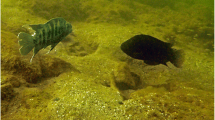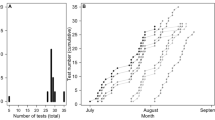Abstract
The rocky shore habitats of the African Great Lakes support high densities of cichlid fishes, including many closely related/ecologically similar species. Aggressive behaviours between conspecifics, and perhaps heterospecifics, influence this unusually high level of species coexistence. In dichotomous choice aggression trials, male Maylandia thapsinogen were presented simultaneously with two heterospecific intruders (Maylandia emmiltos and Maylandia zebra). M. thapsinogen were significantly more aggressive towards intruders from an allopatric species (similar orange dorsal fin colour—M. emmiltos), than towards a different allopatric species (blue dorsal fin—M. zebra). Aggression biases disappeared when colour differences were masked using monochromatic lighting. A second experiment compared female aggression biases between M. emmiltos with M. thapsinogen, species similarly coloured to one another, the former possessing a yellow, as opposed to a black throat as the latter does. M. thapsinogen preferentially attacked females of their own species in full but not monochromatic light, while female M. emmiltos showed no significant bias in aggression under any lighting. Responses were not affected by olfactory cues provided by the stimulus fish. These results indicate that divergence in colour might facilitate species coexistence in some cases, but not all, which could be important should populations rejoin through lake level drops.

Photographs by Ad Konings

Similar content being viewed by others
References
Alatalo, R. V., L. Gustafsson & A. Lundberg, 1994. Male coloration and species recognition in sympatric flycatchers. Proceedings of the Royal Society of London B 256: 113–118.
Allender, C. J., O. Seehausen, M. E. Knight, G. F. Turner & N. Maclean, 2003. Divergent selection during speciation of Lake Malawi cichlid fishes inferred from parallel radiations in nuptial coloration. Proceedings of the National Academy of Sciences of the United States of America 100: 14074–14079.
Anderson, C. N. & G. F. Grether, 2010. Interspecific aggression and character displacement of competitor recognition in Hetaerina damselflies. Proceedings of the Royal Society of London B 277: 549–555.
Bayani, D.-M., M. Taborsky & J. G. Frommen, 2017. To pee or not to pee: urine signals mediate aggressive interactions in the cooperatively breeding cichlid Neolamprologus pulcher. Behavioral Ecology and Sociobiology 71: 37–45.
Boake, C., D. Andreadis & A. Witzel, 2000. Behavioural isolation between two closely related Hawaiian Drosophila species: the role of courtship. Animal Behaviour 60: 495–501.
Boughman, J. W., 2001. Divergent sexual selection enhances reproductive isolation in sticklebacks. Nature 411: 944–948.
Blais, J., M. Plenderleith, C. Rico, M. I. Taylor, O. Seehausen, C. van Oosterhout & G. F. Turner, 2009. Assortative mating among Lake Malawi cichlid fish populations is not simply predictable from male nuptial colour. BMC Evolutionary Biology 9: 1–12.
Carleton, K. L. & T. D. Kocher, 2001. Cone opsin genes of African cichlid fishes: tuning spectral sensitivity by differential gene expression. Molecular Biology and Evolution 18: 1540–1550.
Carleton, K. H., F. I. Hárosi & T. D. Kocher, 2000. Visual pigments of African cichlid fishes: evidence for ultraviolet vision from microspectrophotometry and DNA sequences. Vision Research 40(8): 879–890.
Coyne, J. A., S. Y. Kim, A. S. Chang, D. Lachaise & S. Elwyn, 2002. Sexual isolation between two sibling species with overlapping ranges: sexual isolation between two sibling species with overlapping ranges: Drosophila santomea and Drosophila yakuba. Proceedings of the Royal Society of London B 56: 2424–2434.
Dalton, B. E., T. W. Cronin, N. J. Marshall & K. L. Carleton, 2010. The fish eye view: are cichlids conspicuous? Journal of Experimental Biology 213: 2243–2255.
Deitloff, J., J. O. Church, D. C. Adams & R. G. Jaeger, 2009. Interspecific agonistic behaviours in a salamander community: implications for alpha selection. Herpetologica 65: 174–182.
Deutsch, J. C., 1997. Colour diversification in Malawi cichlids: evidence for adaptation, reinforcement or sexual selection? Biological Journal of the Linnean Society 62: 1–14.
Dijkstra, P. D., O. Seehausen, B. L. A. Gricar, M. E. Maan & T. G. G. Groothuis, 2005. Can male-male competition stabilize speciation? A test in Lake Victoria haplochromine cichlid fish. Behavioral Ecology and Sociobiology 59: 704–713.
Dijkstra, P. D., O. Seehausen & B. L. A. Gricar, 2006. Can male-male competition stabilize speciation? A test in Lake Victoria haplochromine cichlid fish. Behavioral Ecology and Sociobiology 59: 704–713.
Dijkstra, P. D., C. Hemelrijk, O. Seehausen & T. G. G. Groothuis, 2008. Colour polymorphism and intrasexual competition in assemblages of cichlid fish. Behavioural Ecology 20: 138–144.
Dijkstra, P. D., J. Lindstrom, N. B. Metcalfe, C. K. Hemelrijk, M. Brendel, O. Seehausen & T. G. G. Groothuis, 2010. Frequency-dependent social dominance in a colour polymorphic cichlid fish. Evolution 64: 2797–2807.
Genner, M. J. & G. F. Turner, 2005. The mbuna cichlids of Lake Malawi: a model for rapid speciation and adaptive radiation. Fish and Fisheries 6: 1–34.
Genner, M. J., G. F. Turner & S. J. Hawkins, 1999. Resource control by territorial male cichlid fish in Lake Malawi. Journal of Animal Ecology 68: 522–529.
Grether, G. F., N. Losin, C. N. Anderson & K. Okamoto, 2009. The role of interspecific interference competition in character displacement and the evolution of competitor recognition. Biological Reviews 84: 617–635.
Holzberg, S., 1978. Field and laboratory study of behaviour and ecology of Pseudotropheus zebra (Boulenger), an endemic cichlid of Lake Malawi (Pisces-Cichlidae). Zeitschrift fur Zoologische Systematik und Evolutionsforschung 16: 171–187.
Kohda, M. & S. K. Mboko, 1994. Aggressive behaviours of territorial Cichlid Fishes against larger heterospecific intruders. African Study Monographs 15: 69–75.
Knight, M. E. & G. F. Turner, 2004. Laboratory mating trials indicate incipient speciation by sexual selection among populations of the cichlid fish Pseudotropheus zebra from Lake Malawi. Proceedings of the Royal Society of London B 271: 675–680.
Konings, A., 2007. Malawi cichlids in their natural habitat, 4th revised ed. Cichlid Press, El Paso: 1–424.
Maan, M. E., O. Seehausen, L. Soderberg, L. Johnson, E. A. P. Ripmeester, H. D. J. Mrosso, M. I. Taylor, T. J. M. van Dooren & J. J. M. van Alphen, 2004. Intraspecific sexual selection on a speciation trait, male coloration, in the Lake Victoria cichlid Pundamilia nyererei. Proceedings of the Royal Society of London B 271: 2445–2452.
Marsh, B. A., A. C. Marsh & A. J. Ribbin, 1986. Reproductive seasonality in a group of rock-frequenting cichlid fishes in Lake Malawi. Journal of Zoology 209: 9–20.
Myers, G. S., 1960. Fish evolution in Lake Nyasa. Evolution 14: 394–396.
Pauers, M. J., J. M. Kapfer, C. E. Fendos & C. S. Berg, 2008. Aggressive biases towards similarly coloured males in Lake Malawi cichlid fishes. Biology Letters 4(2): 156–159.
Sabbah, S., S. M. Gray, E. S. Boss, J. M. Fraser, R. Zatha & C. W. Hawryshyn, 2011. The underwater photic environment of Cape Maclear, Lake Malawi: comparison between rock- and sand-bottom habitats and implications for cichlid fish vision. Journal of Experimental Biology 214: 487–500.
Scholz, C. A., T. C. Johnson, A. S. Cohen, J. W. King, J. A. Peck, J. T. Overpeck, M. R. Talbot, E. T. Brown, L. Kalindekafe, P. Y. O. Amoako, R. P. Lyons, T. M. Shanahan, I. S. Castaneda, C. W. Heil, S. L. Forman, L. R. Mchargue, K. R. Beuning, J. Gomez & J. Pierson, 2007. East African megadroughts between 135 and 75 thousand years ago and bearing on early-modern human origins. Proceedings of the National Academy of Sciences of the United States of America 104: 16416–16421.
Seehausen, O., 1996. Distribution of and reproductive isolation among colour morphs of a rock-dwelling Lake Victoria Cichlid (Haplochromis nyererei). Ecology of freshwater fish 5: 195–202.
Seehausen, O. & D. Schluter, 2004. Male-male competition and nuptial-colour displacement as a diversifying force in Lake Victoria cichlid fishes. Proceedings of Biological Sciences of the Royal Society 271: 1345–1353.
Smith, P. F. & I. Kornfield, 2002. Phylogeography of Lake Malawi cichlids of the genus Pseudotropheus: significance of allopatric colour variation. Proceedings of the Royal Society of London B 269: 2495–2502.
Spady, T. C., O. Seehausen, E. R. Loew, R. C. Jordan, T. D. Kocher & K. L. Carleton, 2005. Adaptive molecular evolution in the opsin genes of rapidly speciating cichlid species. Molecular Biology and Evolution 22: 1412–1422.
Stauffer, J. R., N. J. Bowers, K. A. Kellogg & K. R. McKaye, 1997. A revision of the blue-black Pseudotropheus zebra (Teleostei: Cichlidae) complex from Lake Malawi, Africa, with a description of a new genus and ten new species. Proceedings of the Academy of Natural Sciences of Philadelphia 148: 189–230.
Tynkkynen, K., M. J. Rantala & J. Suhonen, 2004. Interspecific aggression and character displacement in the damselfly Calopteryx splendens. Journal of Evolutionary Biology 17: 759–767.
Tynkkynen, K., J. S. Kotiaho, M. Luojumäki & J. Suhonen, 2006. Interspecific territoriality in Calopteryx damselflies: the role of secondary sexual characters. Animal Behaviour 71(2): 299–306.
Young, K. A., J. M. Whitman & G. F. Turner, 2009. Secondary contact during adaptive radiation: a community matrix for Lake Malawi cichlids. Journal of Evolutionary Biology 22: 882–889.
Acknowledgements
This study was supported by a PhD scholarship funded by Bangor University. We thank Ad Konings for the use of photographs and the late Ashley Tweedale for assistance with maintenance of the fish and aquarium facilities. We are grateful to the reviewers for their helpful suggestions.
Author information
Authors and Affiliations
Corresponding author
Additional information
Handling editor: I. A. Nagelkerken
Rights and permissions
About this article
Cite this article
Cooke, G.M., Turner, G.F. Team colours matter when playing away from home: aggression biases in geographically isolated mbuna cichlid populations. Hydrobiologia 809, 31–40 (2018). https://doi.org/10.1007/s10750-017-3442-6
Received:
Revised:
Accepted:
Published:
Issue Date:
DOI: https://doi.org/10.1007/s10750-017-3442-6




